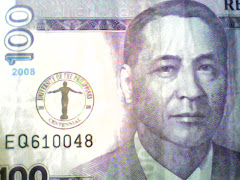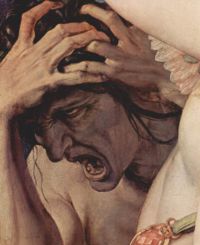Thursday, February 4, 2010
Art Stud 2 Midterm Essay 1
Here the red clashes against the white, the white curves and writhes into eight letters that make an empire. Here too stands a man with his eyes to the ground, with a sweet, bubbly dagger to his heart. But there, there is a closed window tells you that a horse is a door, yet a valise is still a valise. These works are fifty-five years apart, but they both rely on established conventions to convey a meaning. One uses predetermined symbols to denote a stand; the other combines symbols with words to unsettle what is known.
Antipas Delotavo’s “Itak sa Puso ni Mang Juan” is fairly easy to understand. At a glance one can see what the artist’s message is: that capitalism has brought more heartache than joy to the Filipino working class. The Filipino image, represented by Mang Juan in his work clothes, conveys sadness and even hopelessness with a downturned face and sullenness to his expression. The figure is walking, and in my imagination, slowly, towards the left, perhaps representing how capitalism is leading the common Filipino farther away from development. It is interesting for me how his arms are drawn, one holding the other back. And up until now, I didn’t notice how the end of the first capital “C” resembled a dagger, or even a demon’s tail as artists draw it. There is a striking difference between this work of art and the Coca-Cola slogan “Open Happiness.” It also contradicts the myriad commercials that claim Coca-Cola fosters unity, friendship, family values and even love, and exposes them for what really they are: bids for more sales. And at the expense of Mang Juan, no less.
On the other hand, Rene Magritte’s “The Key of Dreams” aims to question our association of names with objects. There are four “windows,” the first from the left is the horse labeled as “the door,” the second, the clock labeled “the wind,” third, the jug, labeled “the bird,” and fourth, the valise called, as convention would deem correct, “the valise.”
The first time I saw this painting, I was thoroughly disconcerted. What on earth does the horse have in connection with a door, or the jug with a bird? The time and the wind I can understand, they are both abstract and intangible. And why is it called the “Key to Dreams?” But that was a slide in a PowerPoint presentation, and I soon forgot about it.
Upon further evaluation, I believe this work aims to make people realize how much of the world is socially constructed; how much exists only because we make them so. But the unsettling feeling caused by this is somewhat quelled by the last square: “Hey, maybe you’re right, maybe it is a valise.” Perhaps it is also a foray into the fascination of people with their dreams and interpreting their dreams, and Magritte is also trying to say that dreams are representations of objects that do not make sense at times because our subconscious and unconscious are taking over. But sometimes our conscious selves break through, as is expressed by his fourth square in the painting. I think that the usage of color—shades of brown and white—give a character of warmth and solidity to it that also contradicts the “dream” aspect. A question of color association as well?
Magritte once said, “To be a surrealist... means barring from your mind all remembrance of what you have seen, and being always on the lookout for what has never been.” Surrealism, I think, is very powerful, as anything strange in a sense creates an entire new world of thought that convention would not allow.
To me, both Antipas Delotavo’s Itak sa Puso ni Mang Juan and René Magritte’s Key to Dreams invite us to look closer, and at the same time, beyond, everyday objects. These artists implore us to not take anything for granted, to take a more active interest in the world we have created for ourselves through words and images.
Antipas Delotavo’s “Itak sa Puso ni Mang Juan” is fairly easy to understand. At a glance one can see what the artist’s message is: that capitalism has brought more heartache than joy to the Filipino working class. The Filipino image, represented by Mang Juan in his work clothes, conveys sadness and even hopelessness with a downturned face and sullenness to his expression. The figure is walking, and in my imagination, slowly, towards the left, perhaps representing how capitalism is leading the common Filipino farther away from development. It is interesting for me how his arms are drawn, one holding the other back. And up until now, I didn’t notice how the end of the first capital “C” resembled a dagger, or even a demon’s tail as artists draw it. There is a striking difference between this work of art and the Coca-Cola slogan “Open Happiness.” It also contradicts the myriad commercials that claim Coca-Cola fosters unity, friendship, family values and even love, and exposes them for what really they are: bids for more sales. And at the expense of Mang Juan, no less.
On the other hand, Rene Magritte’s “The Key of Dreams” aims to question our association of names with objects. There are four “windows,” the first from the left is the horse labeled as “the door,” the second, the clock labeled “the wind,” third, the jug, labeled “the bird,” and fourth, the valise called, as convention would deem correct, “the valise.”
The first time I saw this painting, I was thoroughly disconcerted. What on earth does the horse have in connection with a door, or the jug with a bird? The time and the wind I can understand, they are both abstract and intangible. And why is it called the “Key to Dreams?” But that was a slide in a PowerPoint presentation, and I soon forgot about it.
Upon further evaluation, I believe this work aims to make people realize how much of the world is socially constructed; how much exists only because we make them so. But the unsettling feeling caused by this is somewhat quelled by the last square: “Hey, maybe you’re right, maybe it is a valise.” Perhaps it is also a foray into the fascination of people with their dreams and interpreting their dreams, and Magritte is also trying to say that dreams are representations of objects that do not make sense at times because our subconscious and unconscious are taking over. But sometimes our conscious selves break through, as is expressed by his fourth square in the painting. I think that the usage of color—shades of brown and white—give a character of warmth and solidity to it that also contradicts the “dream” aspect. A question of color association as well?
Magritte once said, “To be a surrealist... means barring from your mind all remembrance of what you have seen, and being always on the lookout for what has never been.” Surrealism, I think, is very powerful, as anything strange in a sense creates an entire new world of thought that convention would not allow.
To me, both Antipas Delotavo’s Itak sa Puso ni Mang Juan and René Magritte’s Key to Dreams invite us to look closer, and at the same time, beyond, everyday objects. These artists implore us to not take anything for granted, to take a more active interest in the world we have created for ourselves through words and images.
Subscribe to:
Post Comments (Atom)














Cool! Were you under Sofia Guillermo for Art Stud 2?
ReplyDelete